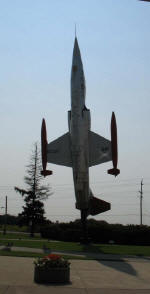
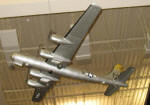





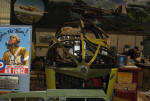

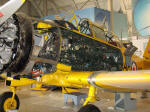

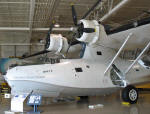


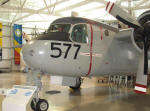






The Canadian Warplane Museum is located right next to the Hamilton International Airport, located in the outskirts of Hamilton. It is one of the uncommon airplane museums where a large number of the planes on display actually fly. Of course, the smell of avgas, oil and ozone give the museum a lot more ďatmosphereĒ than the typical floor wax odor of most museums.
The museum building is attached to a large hanger that is right next to the Hamilton International Airport Flight Line. This is done purposely as one can easily taxi a plane from the hanger and onto the runway.
The museum scope covers the entire era of Canadian military flight from World War I to the modern day. This facility was a replacement for the one that burnt down in 1993 which cost the museum its flying Hawker Hurricane Mark I among others.
The museum portion of the building has all the usual museum displays at the beginning including a series of display models made by local modelers organized by the various eras of Canadian military aviation (WW1, post War, WW2, Cold War, etc.) There are a small number of museum displays including a cut way of a Lancaster bomber as well as uniforms, medals, paintings and photographs. Among the more unusual items is one of the original G-suits (a Canadian invention by Dr Wilbur R Franks from the University of Toronto.)
Once you are done with the displays then it is onto the hanger itself where all the planes are. The planes are not organized in any particular chronological order, but it seems to be done on the basis of flyability as those planes that can and do fly are located closer to the hanger doors while those can not are tucked away in the back. This might explain why one sees mostly jets as they enter the main part of the museum. Due to restrictions in Canada, it is not legal for civilians to own flyable military jets so all retired CAF jets have their center spars cut to prevent them flying. Even if it were legal to fly the jets, the museum probably wouldnít fly them as to get them airborne would take a lot more money than the museum has available.
The black CF-100 Clunk is very prominent as soon as you step into the hangar. If you ask the museum volunteers nicely, you can climb up the stairs and sit in the pilotís cockpit (which Iíve done.) The seat rides a little higher than in real life, but it was done to accommodate little kids and not the kids in adult bodies. Otherwise there arenít many hands on type displays, but I donít mind that as much as kids might.
One thing you will notice is that most of the planes are missing barriers as the museum recognizes the fact that people like to poke around. The rule of thumb here is that you can get up close and personal as long as you respect the equipment. The only planes that do have barriers are the more fragile planes like the biplanes. The museum seems to be designed for wandering as there is no definitive path. Each of the planes has a small plaque that describes its history and specs.
Plenty of planes to gawk at including a flyable PBY Canso (aka Catalina), flyable DC-3 Dakota, flyable B-25D Mitchell, various marks of flyable Harvard/SNJ/Texans, a could be flyable, but not S-2 Tracker, a non-flyable CT-114 Tudor, non-flyable Canadair F-86 Mk6, non-flyable CF-5A, non-flyable CF-104, a flyable Sopwith Pup replica, flyable Anson and the crown jewel of the museum, the only flying Lancaster in North America and only one of two in the world. Just be careful of the oil pans lying about!
Often times, you can see the planes opened up and maintenance teams working on the planes. This gives plane junkies a chance to see the guts of the aircraft up close and personal.
The shop area where volunteers (usually retired military and aviation types) do the restoration work is on one side of the museum and can be viewed by the public. Two of the long term projects being worked on are the Westland Lysander target tug and the Bolingbroke (the Canadian made version of the Blenheim bomber.)
One of the things the museum does is organize flights in Stearman biplanes or Harvard trainers for those who are willing to fork out $250 CDN bucks for a 20 minute flight. Also if you have a lot of spare cash on hand, you can be one of those who get to fly in the Lancaster. This is one way for the museum to defray the costs of operating increasingly expensive aircraft.
This is one of my favorite aviation museums to visit and is a treasure trove of information for those with an interest in Canadian military aviation.